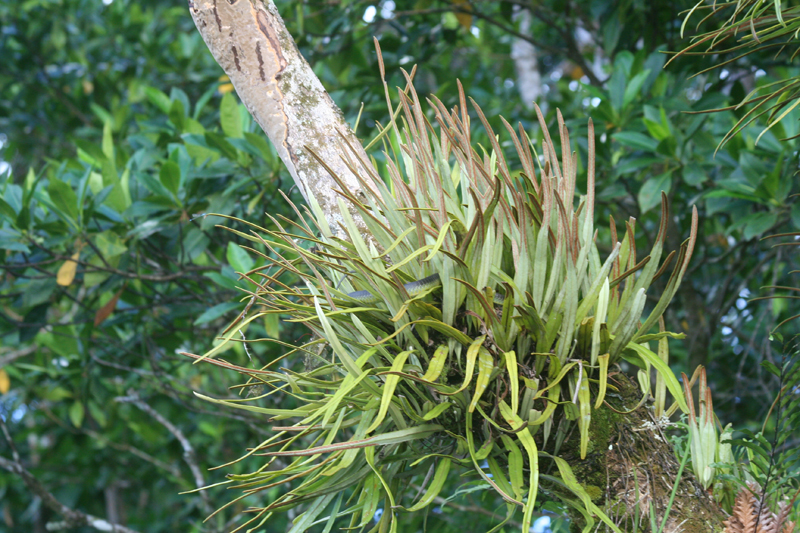
| Preface | Perth | Stuart Highway | Uluru | Port Douglas | Sydney | Sturt Highway | Kangaroo Island | Indian Pacific | Perth |
Port Douglas—Where the rain forest meets the coral sea
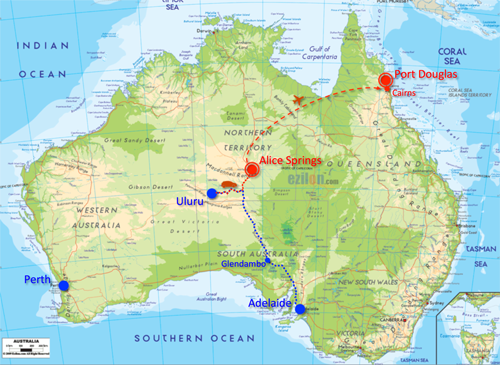
This was the longest section of the trip: five nights in one location. And what a location. "The only place on the planet where two (completely different) world heritage sites meet." So claimed one of our guides. I love this sort of bold, brash, statement, but I can't leave it unexamined: that's part of the fun of compiling these overblown travelogs. I was on the verge of declaring this one hyperbole, albeit one that was worth granting some poetic license. The World Heritage website gets 10 out of 10 for its esoteric language, but 2 out of 10 for its search engine which is almost useless if you do not know the exact title given to the area. Great Barrier Reef is not too hard to figure out, but Gondwana Rainforests of Australia? And since having found that it described so precisely what Daintree is, but it is 1,000 miles to the south, I was ready to conclude that Daintree sadly did not have this status when I found a reference on the Daintree Rainforest Wikipedia page to the Wet Tropics of Queensland World Heritage site, and sure enough buried on that page is one reference to the Daintree River. Ta dah! So the country north of Port Douglas is indeed "The only place on the planet where two (completely different) world heritage sites meet." The beaches where the rain forest meets the coral sea. The world's oldest surviving biomass, with many primitive plant species flourishing since before Gondwana broke up to form today's continents 170 million years ago, next to the world's largest living organism.
The game plan was to spend two days at sea, alternating with two days in the rain forest. To cut ourselves a little slack, the first (rain forest) day we only had a reservation for dusk: a boat tour on the Daintree river. So much for the plan.
Part 1:
- Julaten: Our tropical retreat
- Mossman Gorge: Chip's forest walk
- Daintree River: Murray's boat tour
Part 2:
- Cape Tribulation: Nick's Day Tour
- Great Barrier Reef
- Port Douglas (my unplanned "rest day")
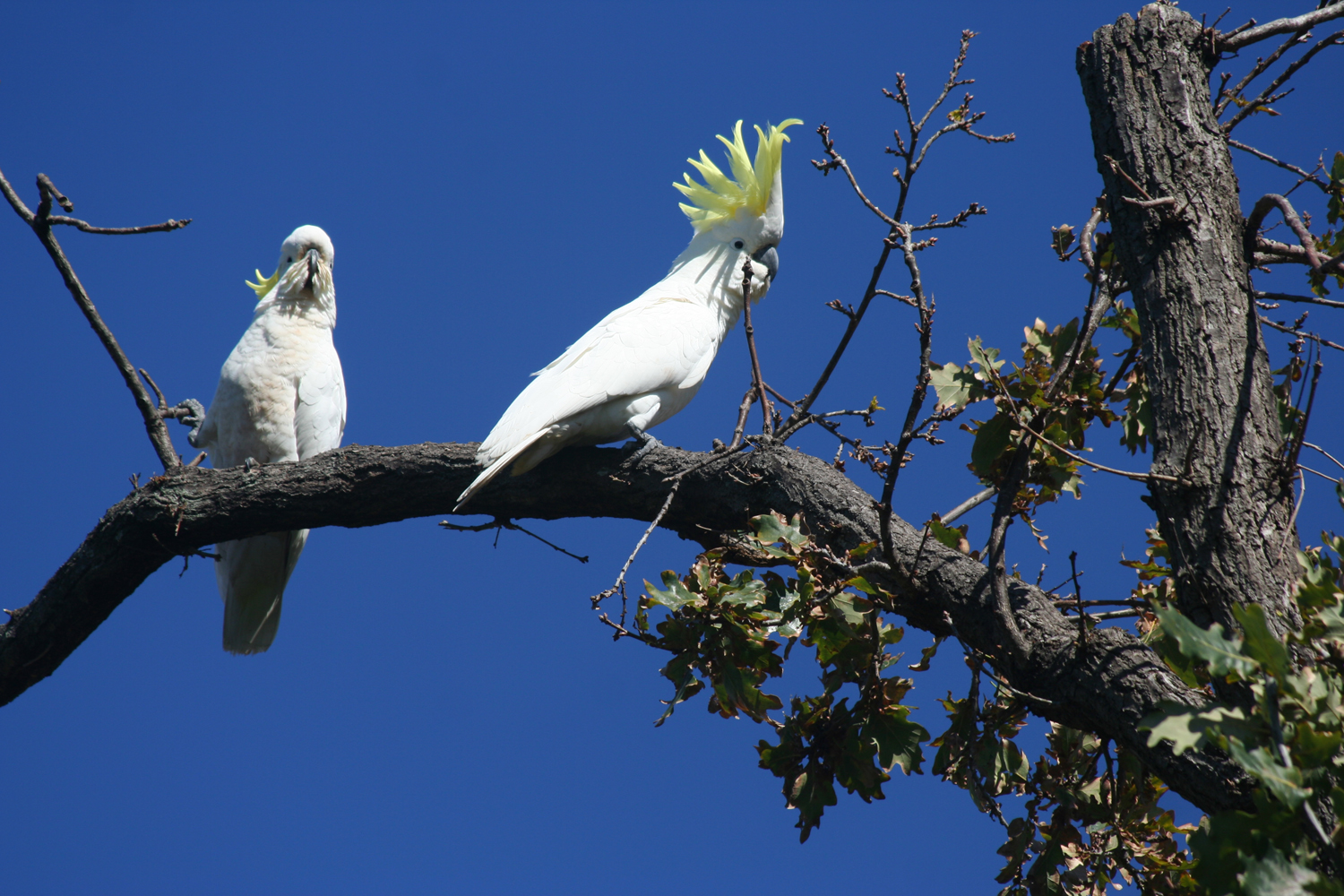
Julaten
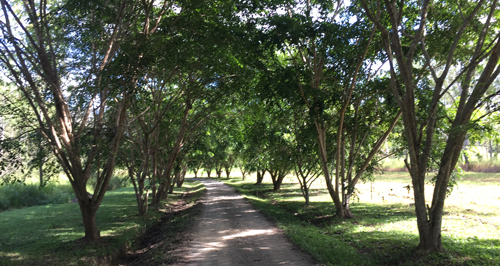 The lovely avenue of trees
that formed the first couple of hundred yards of the driveway and
The lovely avenue of trees
that formed the first couple of hundred yards of the driveway and which I never remembered to ask about, so I still don't know the species of tree.
But before we get to that, Julaten our home from home for nearly a week deserves its own section. High on the table lands behind Port Douglas, it was a serious challenge to find every time we came home, and especially so in the dark on our first arrival. The main road from Cairns to Port Douglas was a narrow two lane road that bobbed and weaved along the coast line. Between nightfall and the crowding trees (sometimes even providing a complete canopy so we were driving through a tunnel) it was only the GPS that gave us any clue just how close the water was. As we turned inland at Port Douglas the road straightened momentarily before we turned off to head up the mountain where the serious switch backs started. We were instructed to start looking for the sign "about ten miles after you get to the top of the mountain" which sounded pretty clear until you remember we were not going over the mountain, we were simply climbing to its flat top, so there was no abrupt change from ascent to descent. More challenging still "the sign is kinda hard to see in the dark" and "some cars do a better job illuminating it than others." Claudia saw it at the last second, and we peeled off onto the dirt road. Down about a quarter of a mile before an even smaller turn to the right. Now the brush swept the car on both sides, but eventually gave way to a small meadow revealing to our considerable relief the two small lodges we were expecting. We parked outside the second one, and let ourselves in. Now there was validation everywhere: welcome notes, mud maps, and a refridgerator full of Claudia-friendly snacks.
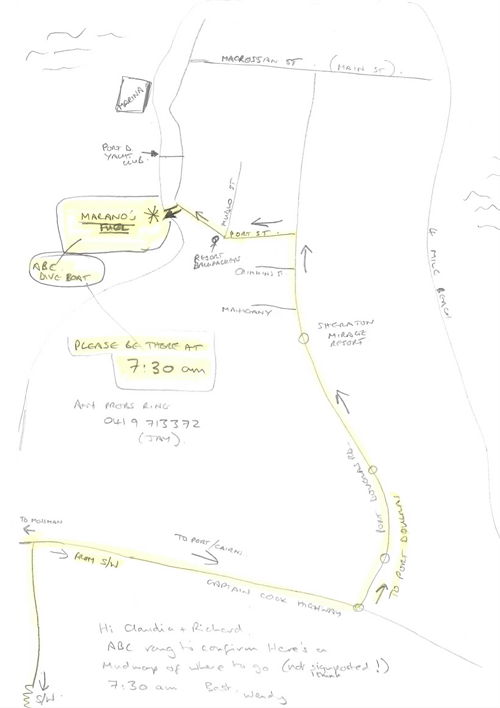 A classic mudmap, drawn by Wendy. It shows not only how to find the Dive Shop / harbour, but also what time
A classic mudmap, drawn by Wendy. It shows not only how to find the Dive Shop / harbour, but also what time
we are expected to be there.
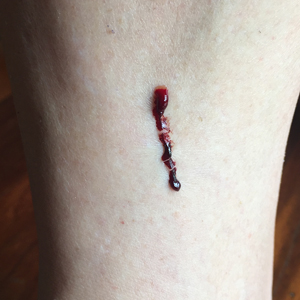 Australian Leeches 2 - RT 0. Two trips two leeches. Both times I was completely oblivious until I happened to notice the leak. This time I never even saw the leech, and s/he must have been disappointed with the product because this little dribble is nothing in comparison to the sock-soaking episode in 2005.
Australian Leeches 2 - RT 0. Two trips two leeches. Both times I was completely oblivious until I happened to notice the leak. This time I never even saw the leech, and s/he must have been disappointed with the product because this little dribble is nothing in comparison to the sock-soaking episode in 2005.
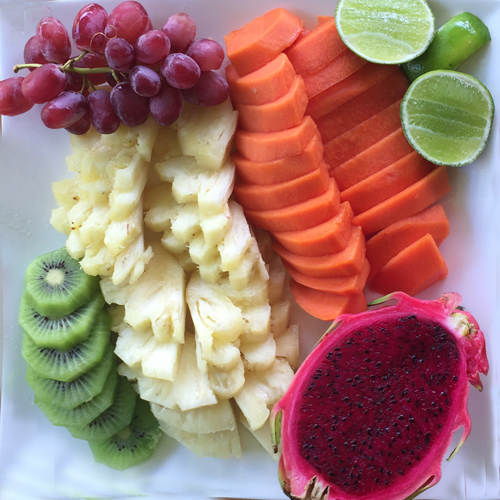 The breakfast platter left for us in the refrigerator.
The breakfast platter left for us in the refrigerator. 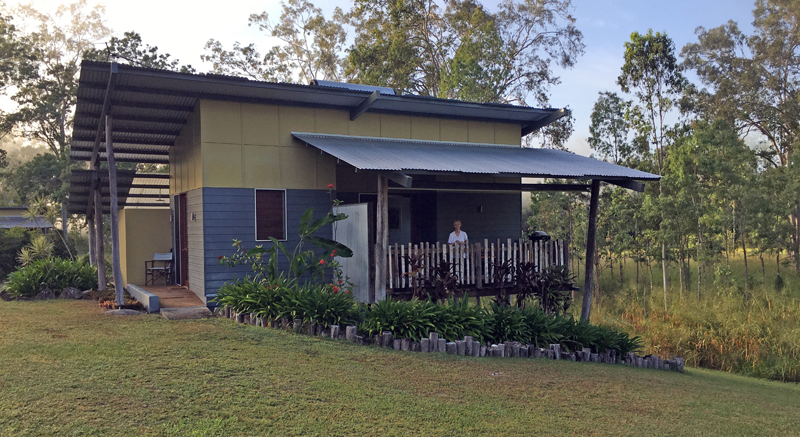
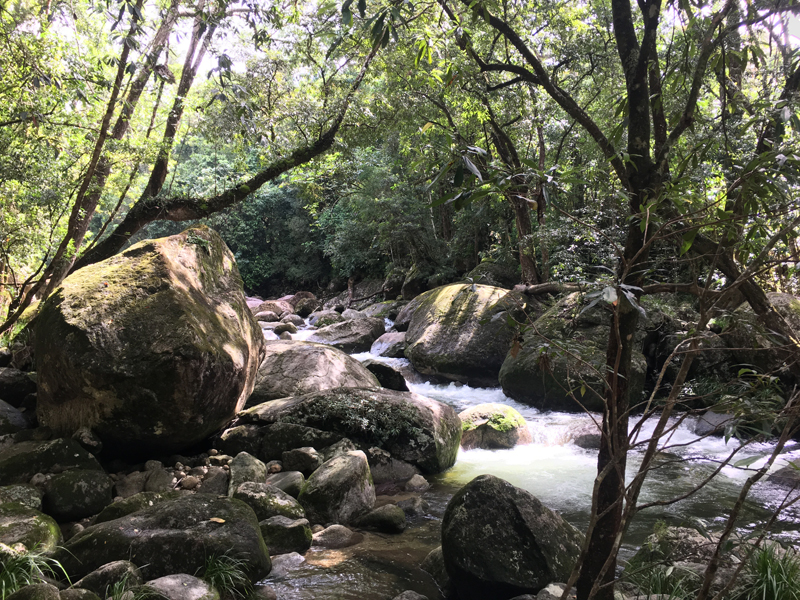
The lodge was nothing short of a work of art. It could have been, and for all I know had been, featured in Architecture Digest. The entry way was divided off from the main living space / bedroom by hardwood 2x2 slats that separated the space like a dotted line across a page. The bed was built into the divider and could only have been custom made by someone with as much heart and art as talent. These talents manifested everywhere. Designed to look as unassuming as a shack, the heavy engineering tying everything together spoke of far more than that. The hardwood floor was a wide mixture of different woods. The corregated sheet roof was galvanised, with the sheets uncut leaving a castellated edge. Out on the veranda was a full-blown kitchen, and the bathroom included a shower whose big glass door led outside to an enclosed and roofed-in-but-definitely-outside shower with a rain head. It was big enough for a rugby team, or me and all our scuba gear being washed and dried.
We crashed. In the morning we'd just started to gather our wits when Wendy arrived. We discussed our plans with her. The first day was mostly open, partly because Claudia wanted to enjoy the lodge, but also because we might have needed the rest. The only plan was the Daintree boat trip, which we'd agreed with the operator to do in the late afternoon, to maximize our viewing opportunities. But I'd heard great things about Mossman Gorge, which Wendy confirmed as essential, thereby saving me from having to twist Claudia's arm. The second rain forest day was reserved as a whole day trip with Peter, who among other credentials had a great reputation for finding cassawaries, which would indeed have been a major coup, since Wayne had failed in this mission back in 2005. Peter was supposed to pick us up from the lodge, but the ride up here made me very nervous about attempting the journey down with someone else at the wheel, and Wendy agreed to call him and arrange a different pickup somewhere, anywhere, after the bottom of the hill.
We met Wendy and her family several times over the next few days. We dropped in to ask questions, or just to get access to the interweb. We were always welcomed, and there was always coffee, or beer, or wine. The whole family was lovely, and it was a pleasure hanging in their relaxed home.
We also took several walks around their property. Given the amount of time, and the number of places I'd devoted to platypus hunting during the 2005 trip, I did not have high hopes for the optimistically named platypus pond. But Claudia was game, and it seemed churlish to dismiss it, even though Wendy and another local we met one evening as he took his constitutional, conceded it had been "some time" since they'd had a sighting. We arrived at dusk as is recommended, and as we should have expected the "lean-to" over looking the pond was a serious industrial operation, with seating for a dozen (or two), a wet-bar, running water and a built-in bar-b-que. A line of bar stools under a long plank countertop looked out across the pond. We took our seats.
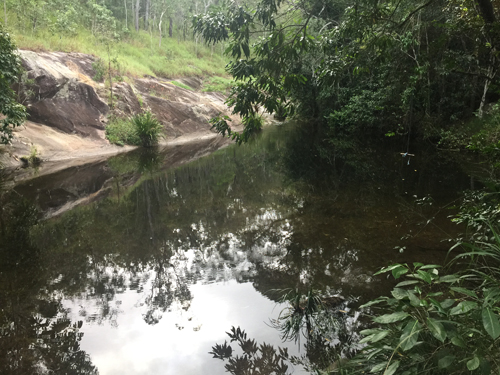
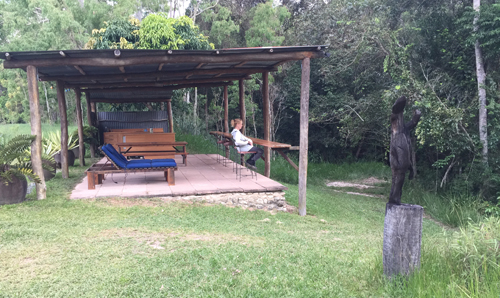
It was definitely prime platypus country. The little pond was probably 100 ft long and 50 ft wide, a rock slab forming the far bank. The was a little bit of current, but the pond itself was still enough to be able to see waterboatmen skimming across the surface, and hopefully to grab our attention if a platypus stuck his nose out. We waited. Birds swooped across the open water catching the evening bugs, and as the light faded, bats began appearing to take over the night shift. I moved closer to the water's edge, and was stood so still the bats were buzzing me. One was so close I heard its wings and felt the breath of wind as it flittered by. We waited. There was only just light to see it when the tell-tale snout and little round head popped up. I instantly grabbed a photo and just as instantly the head disappeared again with the sound of the shutter. Claudia was furious and hissed "Stop that!!" doing her best to slap me without further diminishing our chances of a further sighting. But almost immediately he was back. This time for three or four unmistakable seconds. We could clearly make out the beaver tail and the little duck beak plowing a small wake across the pond. In all we had three or four of these brief sightings in the space of about five minutes, and by then it was too dark to see. We counted our blessings, turned on our headlamps, and made for our lodge, hoping our luck would continue and that nothing would come slithering out of the tall grasses that lined the narrow mowed path home.
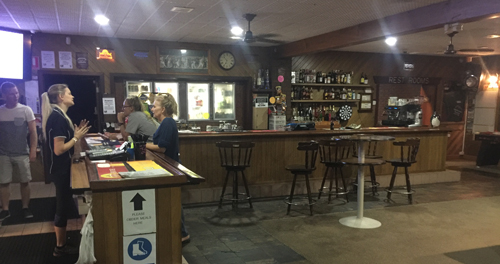
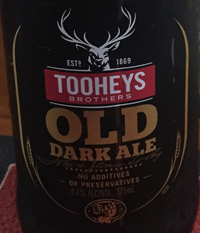
It was still only about 7pm, and the one thing that had not been stocked up in the fridge was beer, so it was time to take my evening constitutional, which in this case meant getting in the car and retracing our steps to The Highlander Tavern I'd noticed about 5 miles back. As I squeezed the car back up the narrow lane to the road, a small round marsupial was caught in the headlights for a few seconds before casually retreating to the safety of the undergrowth. Not much bigger than a large, fat rabbit, if it was smaller than a wallaby that would make it a pademelon, and if it was a pademelon then it was a red-necked pademelon which are the ones "to be found in the coastal regions of Queensland and New South Wales". Excellent.
The Highlander was a typical no-nonsense Ozzie bar and bottle shop, and as usual there were just a handful of patrons in a venue that would support hundreds. The diners sat on the "beautiful outdoor timber deck overlooking Julatten's mesmerising rolling mountains" if only one could see them in the dark, and us drinkers leaned against the bar in the main lounge with its customary kitchen spotlight ambience. They didn't have a great selection of microbrews (none), but my old friend Toohey's Old Dark Ale would go down very nicely thank you. I enjoyed one as I sat, but the barkeep had gone back to her conversation at the other end of the bar so not being fond of my own company, I ordered two more from the bottle shop and headed home, mission accomplished.
Rain forest
If Uluru had given us a flavor of the timelessness of the land and its people, our various Queensland guides, ethnic and otherwise, hammered the message home relentlessly. I was left with a very real sense of these literally geological timeframes and the stark contrast of the recency of the arrival of the Europeans in 1787—nearly 300 years after Columbus stumbled across the Americas.
The Daintree rain forest makes the Amazon look like a baby. Estimates of the age of the Amazon seem to vary from 7 to 20 million years old. Estimates for Daintree vary between 120 and 300 million—easily 10 times older. This fact and and various estimates of the ages threaded through every presentation we listened to.
This is about as much of this stuff as I can stand, but there's way more of it where it came from if it floats your boat: "The Gondwana Rainforest [RT: Of which Daintree seems to be a part] contain outstanding examples of major stages in the Earth’s evolutionary history as well as ongoing evolutionary processes. Major stages represented include the ‘Age of the Pteridophytes’ from the Carboniferous Period with some of the oldest elements of the world’s ferns represented, and the ‘Age of Conifers’ in the Jurassic Period with one of the most significant centres of survival for Araucarians (the most ancient and phylogenetically primitive of the world’s conifers). Likewise the property provides an outstanding record of the ‘Age of the Angiosperms’. This includes a secondary centre of endemism for primitive flowering plants originating in the Early Cretaceous, the most diverse assemblage of relict angiosperm taxa representing the primary radiation of dicotyledons in the mid-Late Cretaceous, a unique record of the evolutionary history of Australian rainforests representing the ‘golden age’ of the Early Tertiary, and a unique record of Miocene vegetation that was the antecedent of modern temperate rainforests in Australia."
To put this in perspective, mammals appeared around 170 million years ago, and today's continents split Gondwana apart after that so this rainforest is almost certainly older than the continent itself. It was a green spot at the height of the last ice age—which it therefore also predates.
Mossman Gorge and Chip |

|
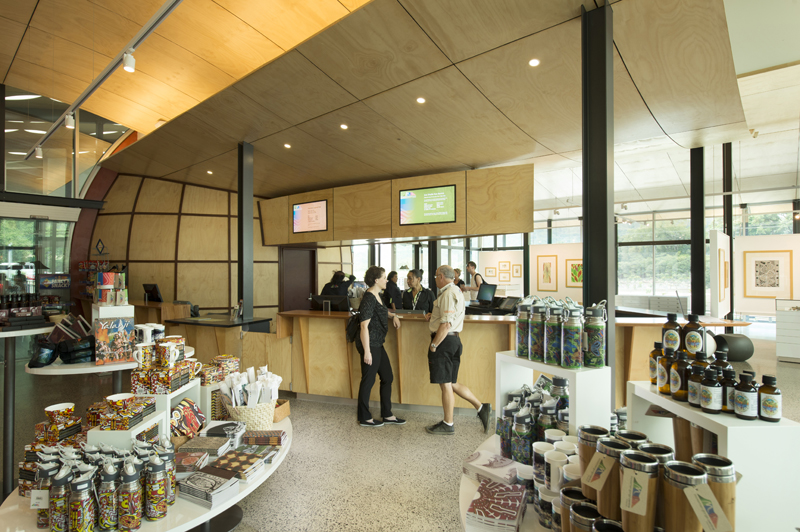 This was one of my favorite tourist trap / gift shops. Lots of local, hand-made, unique, appropriate (and often expensive) items.
This was one of my favorite tourist trap / gift shops. Lots of local, hand-made, unique, appropriate (and often expensive) items.
My banksia seed drink coasters came from here. Photo stolen off the interweb (so that's not me at the counter).
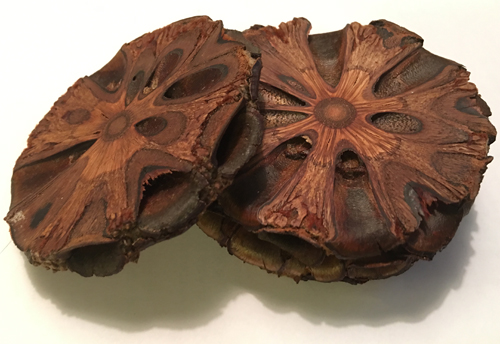 Four 3/8" slices of a banksia seed pod to be used as coasters.
Four 3/8" slices of a banksia seed pod to be used as coasters. The whole seed pod looks like a small wooden pineapple: quite lovely.
After some debate and much encouragement from Wendy, we agreed that we had plenty of time for a casual breakfast but that we would then head for Mossman Gorge.
The Mossman Gorge Centre is an Indigenous eco tourism development serving visitors to the Mossman Gorge World Heritage site. The art gallery and shop showcase the art and crafts of the local Kuku Yalanji artists. More importantly, it is where we picked up our guide. "My name is Yanganda, 'protector of the waterfall'. But you can call me Chip."
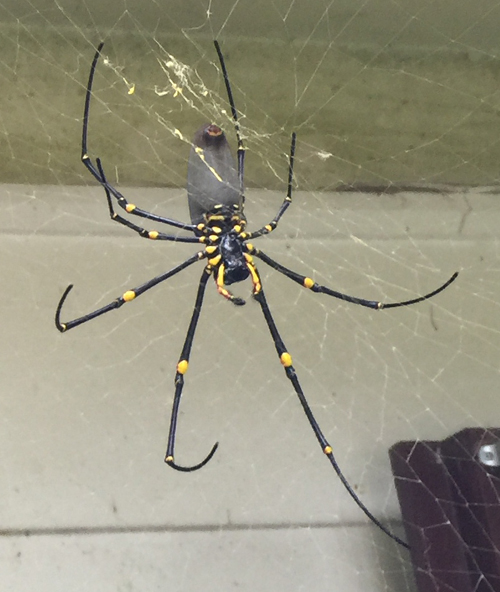 A female Northern Golden Orb weaver Nephila pilipes (Family Araneidae). Though it is a very large
A female Northern Golden Orb weaver Nephila pilipes (Family Araneidae). Though it is a very largespider it is considered to be completely harmless to humans and is quite common in North Queensland.
Kindly identified by Ron Atkinson, owner of the Find a Spider website.
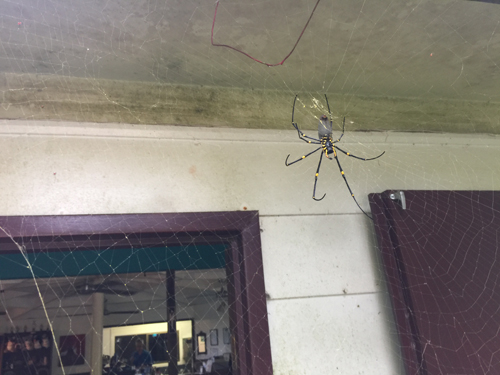
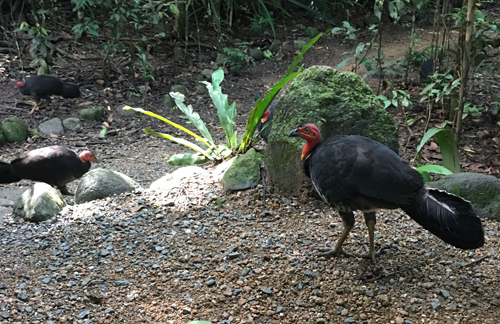
As we were identified we were asked to wait just outside a side door where the shuttle buses pulled in. Guarding this door was the biggest spider we've ever seen. The Amazonian tarantula might have been heavier, meatier, but it was only half the diameter of this thing which easily spanned a dinner plate.
Chip led our little group onto the next shuttle bus into the gorge. (Traffic problems have been solved by banning traffic entirely. Everyone parks for free at the Center and then pays to take the shuttle bus to one or more of the bus stops inside the gorge.) Our stop was for guided tours only. Brush-tailed scrub turkeys "diwan" strutted around the small compound which comprised a fire pit and a small covered area with a table just large enough to seat all of us. But for now we stood around the fire pit. Chip explained that his people (local tribes on the east coast) seem to fairly accurately describe the end of the last ice age (30,000 years ago) when the oceans rose to their present day heights, and over the space of 100 years or so flooded the land east to the continental shelf, more than 100 miles away. Their version of Noah's Flood? Recent archaeological finds out in the reef appear to corroborate this theory, with the detritus of human activity found there carbon-dated to at least 23,000 years ago.
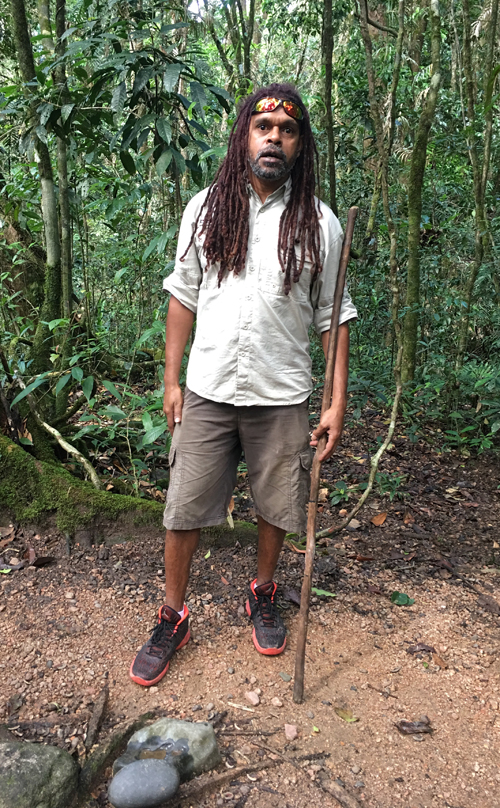 |
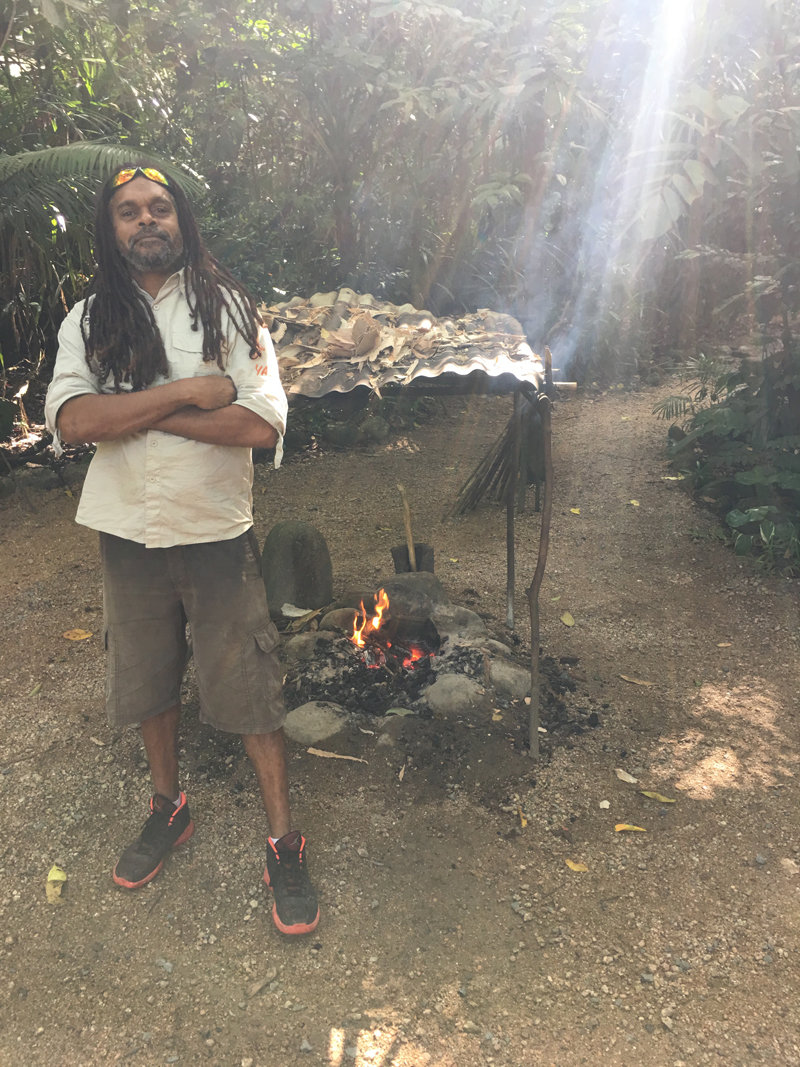 |
|
Chip formally started the proceedings with a traditional ‘smoking’ ceremony that cleanses and wards off bad spirits.. He dropped a few leaves on the embers and fanned up the smoke, which we then solemnly walked through. It sounds corny, but somehow it wasn't. Likewise later when he called out to his ancestors to let them know he was bringing strangers into the forest (the smoke made us all smell the same, which helped them to accept us). The walk meandered through the rainforest and as we wandered, Chip explained more about his people. The Kuku Yalanji people had access to ample food sources including a range of tropical fruits and exotic animal species. Cassowaries, wallabies, tree kangaroos, fish, snakes and pigeons were among the favourites. They had been living in the rainforest for more than 50,000 years before the Europeans showed up and Kuku Yalanji people such as Chuck switched to tourism, educating visitors of their culture and nature. He demonstrated traditional plant use as we went, such as pandanus fruit which can be eaten fresh off the tree, and sasperilla whose stripped leaves bunched up created a foam soap while its bark smelled of tiger balm, and was used for the same purpose. At a small stream he ground up some of the clay to create ochre for painting. We came across a pile of nuts that some animal had clearly made nice neat holes in to extract the nut. Chip claimed this was the Buraga Daintree nut, a type of tamarind. "White-tailed rats are one of the few things that can gnaw through to the kernal. They can eat 150 in a single night." Although I can confirm that white-tailed rats live in the area, and that they have a well-documented penchant for chewing through steel cables and especially plastic-wrapped electrical wire, I can find no reference to the tree, or the rat's prowess at accessing its nuts. That doesn't make it fake news, I'm just saying I could not corroborate the story. When we asked him about climate change, he also claimed that over the last 10 years, the rainy season has moved from Nov-Feb and now is Feb-June, a fact I have not followed up on. Yet. Back in the little compound at the end of the tour, we all sat at the table. There was a small woodstove under the roof and a kettle of water sat on it already close to the boil. Chip quickly rustled up the advertized traditional bush tea and damper. Damper is a traditional Australian soda bread, historically prepared by swagmen, drovers, stockmen and other travellers and since it is cooked "until it sounds hollow when tapped" it definitely needed the tea to help it down. While we gnawed on our snack, Chip produced a didgeridoo and to everyone's delight, but most especially to mine, he proceeded to give my favorite performance of the trip. Better still, Claudia got the whole thing on video. What a great way to finish. Back on the bus, we were returned to the Center, where I bought my banksia coasters (we couldn't afford anything else). We had an excellent light lunch instead, but there wasn't time to take the treetop tour so we had to leave that for next time. |
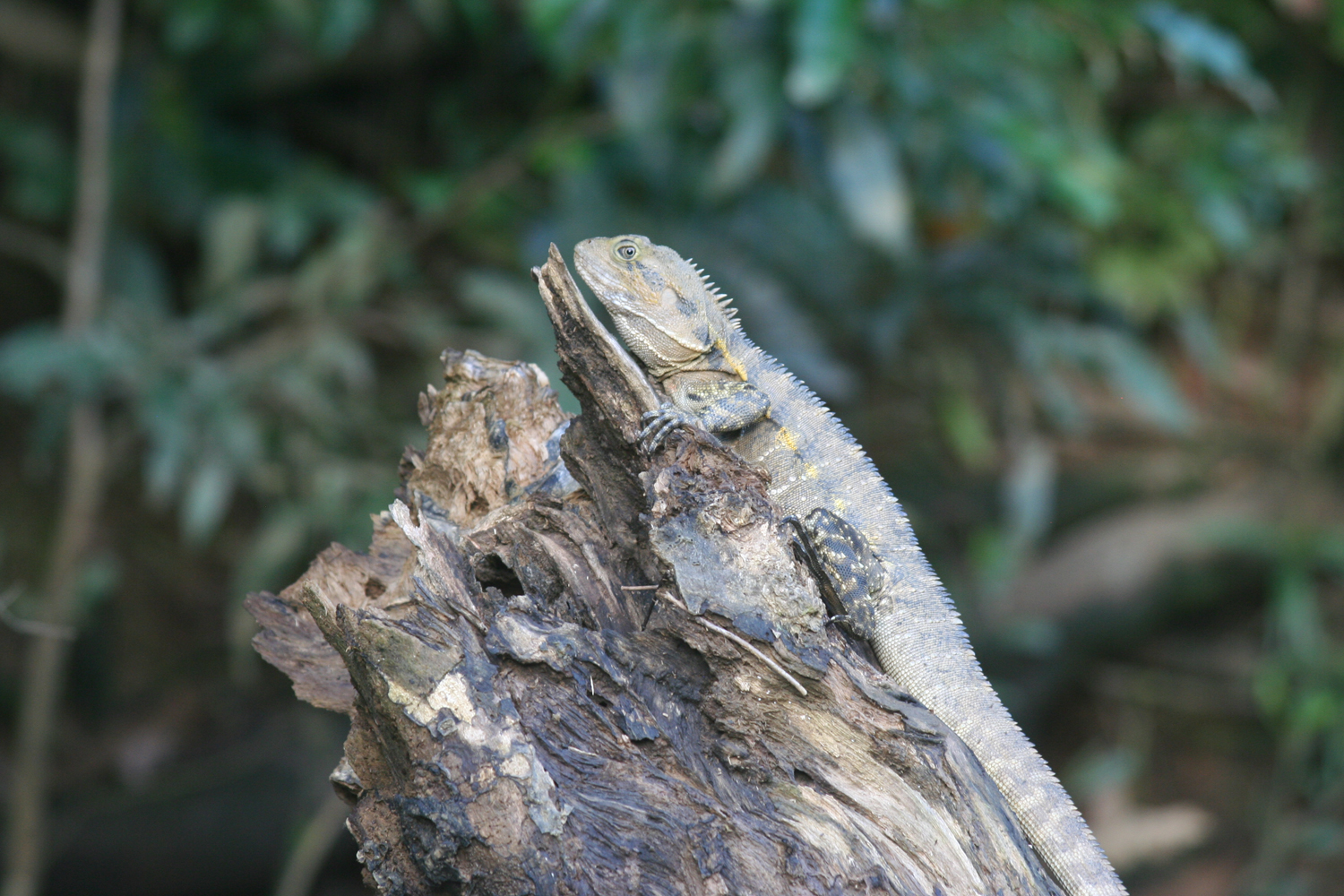
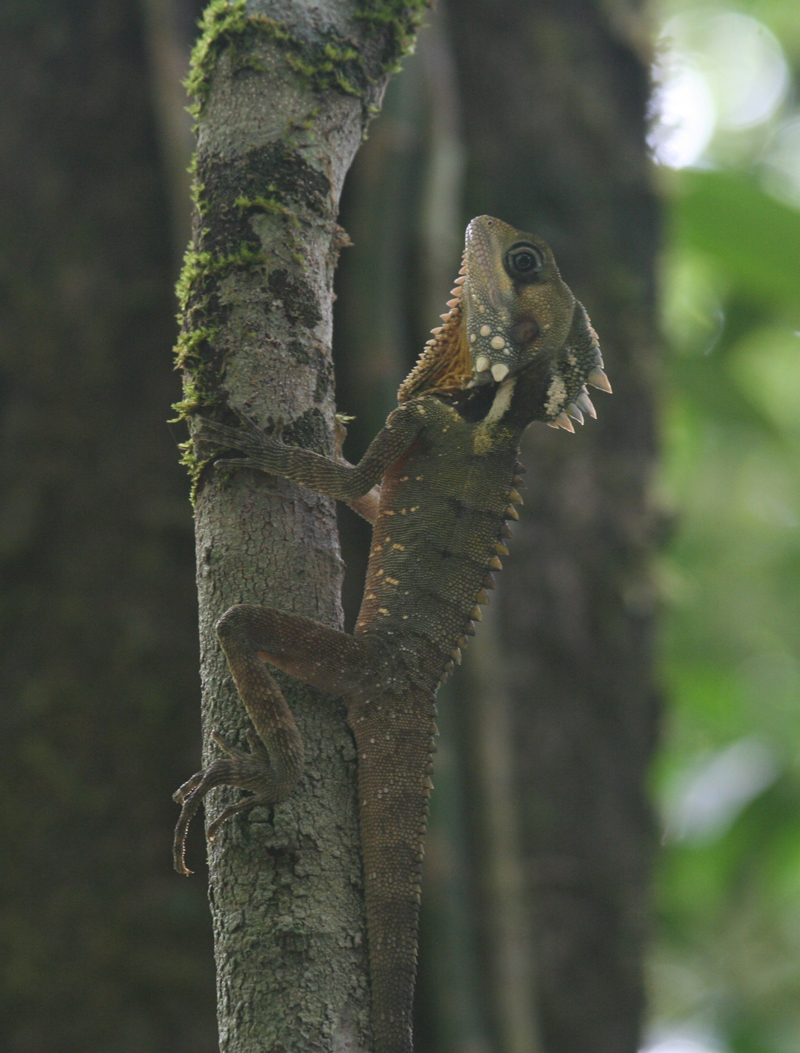
Murry and the Daintree River
By the time we got back to the main road we needed to hustle for the dusk boat tour on the Daintree river. We had paid the very reasonable upgrade charge for a custom tour, which meant that the little boat which might at a pinch have seated a dozen people only needed to seat the two of us, Captain Murray, and Clare, the extremely cute young lady he introduced as "First Mate" in a tone that left no doubt that he intended the double entendre. Murry was clearly master of his domain, a real birder's birder. Clare matched him toe-to-toe, and he was just as clearly not used to that, but she was having such fun playing with him, and he so revelled in flirting with her that it was just a joy to sit there listening to them court and spark as the river floated by. But of course it wasn't just floating by. He was seeing and identifying everything that moved. Unless she saw it first.
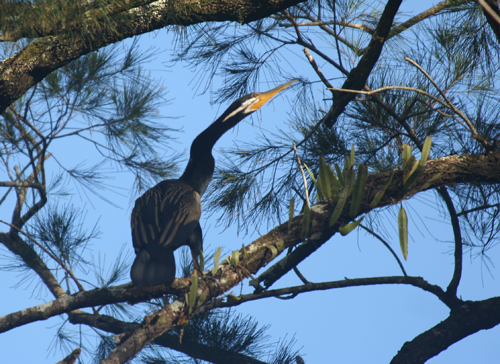 Darter Darter |
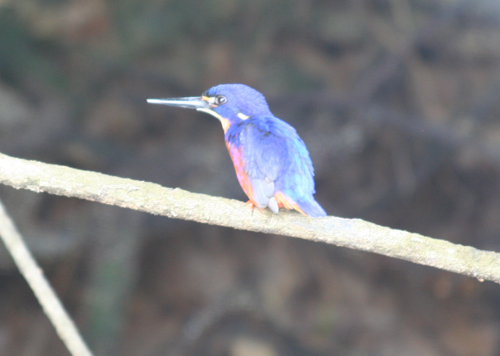 Azure Azure |
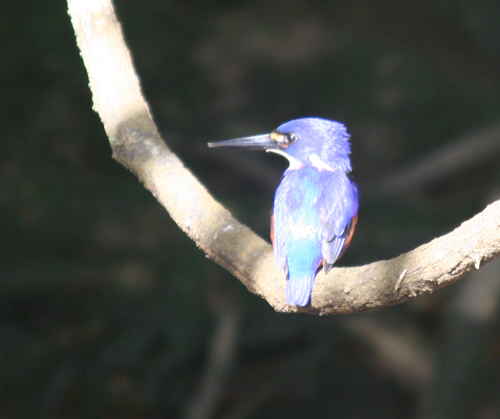 Azure Azure |
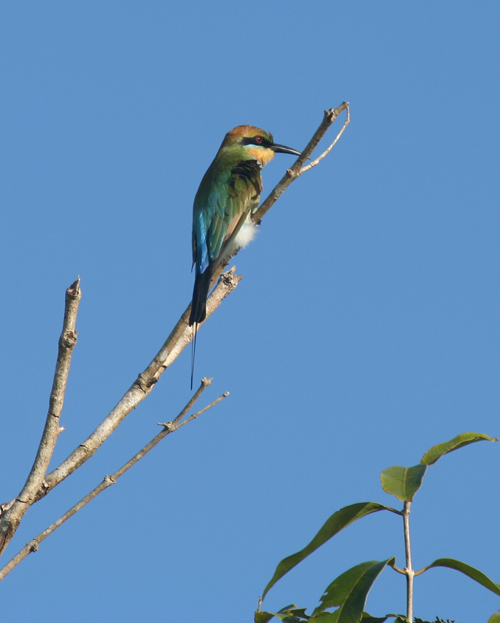 Rainbow Bee-eater Rainbow Bee-eater |
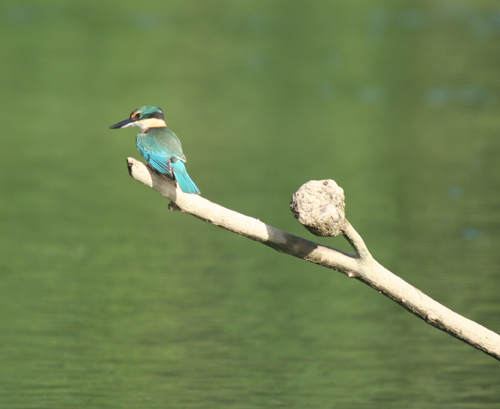 Sacred Sacred |
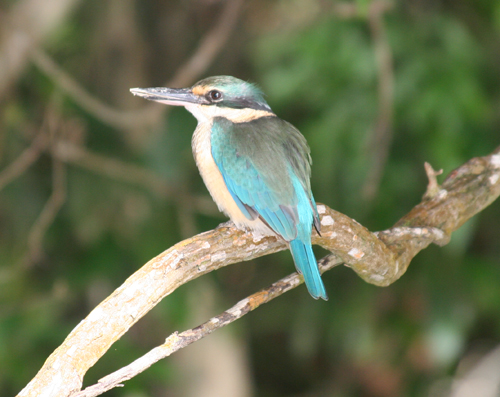 Sacred Sacred |
Anyway we pulled away from the dock and gently made our way up one river bank. It was a perfectly normal scene like a riverbank in any temperate country. Occasional trees and bushes on the banks, a herd of cows in the field behind. Okay they were Brahman cattle, giving the scene a slightly Indian flavor, but it was almost as if we ourselves needed to slow down and relax, because after a while we started to see things. Cattle Egrets with the Brahmans, then azure, forest and sacred kingfishers put on a great show. But everything that moved Murray and or Clare spotted and named: big birds like darters and a white-bellied sea eagle, a striated heron and straw-necked ibis, and smaller ones like rainbow bee-eaters and a bunch of flycatchers. Thornton Peak loomed on the horizon. Murray explained that it was known locally as "the rain-maker. 10 meters of rain per annum. For 135 million years."
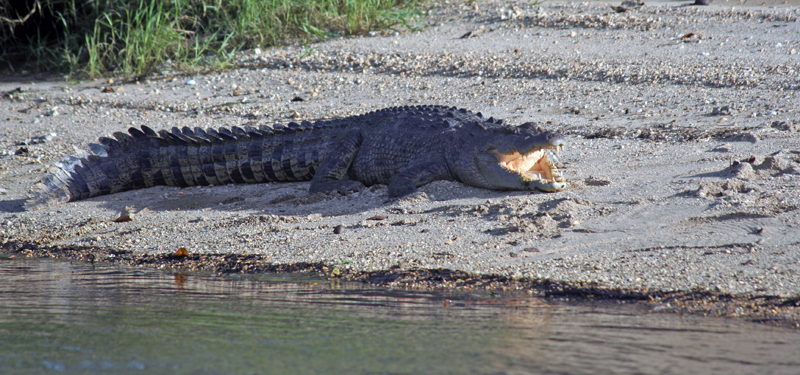
We turned around and plied the river in the other direction. It quickly became clear why we'd gone the way we did. Shortly after we passed our launching point, two crocs sunbathing on the riverbank dispelled all notion of us floating down the Thames or the Hudson. We were close enough to clearly see the palatal valve which Murray pointed out at the back of one of their throats. All species of crocodile have this to seal the opening to the throat, preventing water from entering when the crocodile is submerged but needs its mouth open. The valve can be opened when feeding in air, but it was mostly closed here, giving us a great view.
Further on the banks became more forested, with many of the trees sporting epiphytes growing like great green fur collars half way up their trunks, and freshwater mangroves with their characteristic long toes reaching out in all directions to anchor them in the soft mud. Where the river bank was solid enough to provide a footing for them, Murray pointed out the basket (or fishbone ferns) and the dragon's tongue ferns that looked familiar because they were just like the specimens one sees growing in fat urns in grandma's house, or anywhere Miss Marple might show up.
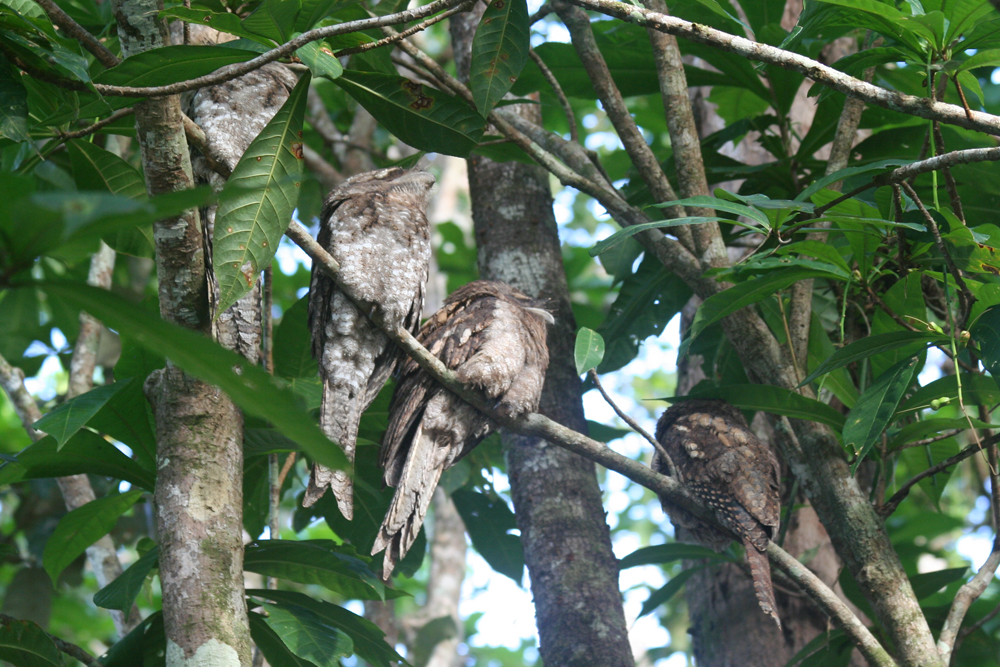
The sightings came thick and fast now. We stared for several minutes at a cluster of Papuan Frogmouths, a cross between owls, Muppets, and Easter Island statues, they blended so well that it was only later while studying my pictures that I was able to convince myself that there were actually four of these large birds huddled together. Next came the green snake tangled up in an epiphyte cluster, and soon after another one more accessibly sprawled along a tree branch. 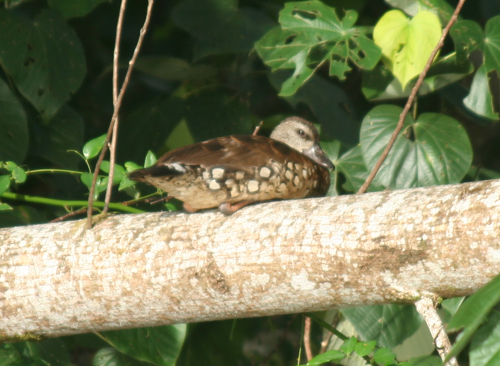
Clare had been very quiet for several minutes while we snapped the snakes, then she yell-whispered "I think it is a Spotted Whistling Duck!" "Nonsense" Murray scoffed. As we motored towards it for a closer look, Murray explained to us (and surely to Clare) that it was unlikely or impossible to be a Spotted Whistling duck because they were native to New Guinea and almost never sighted as far south as this. We got waaay closer, and Murray went silent too. Eventually Clare says "Well?" and I swear she batted her eye lashes at him like some silent movie star. There was a long pause. "It's a Spotted Whistling duck" he announced as if it was a pigeon in Times Square, which made me laugh out loud but it was clearly all a game because when Claudia declared it "rather dull" they instantly and simultaneously came to its defense. |
|
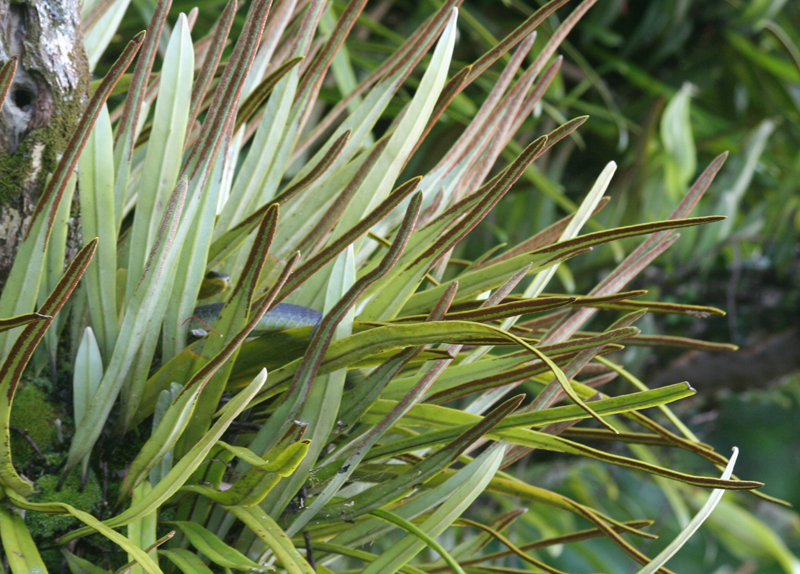 ... but after a minute or so a head eventually appeared. ... but after a minute or so a head eventually appeared. |
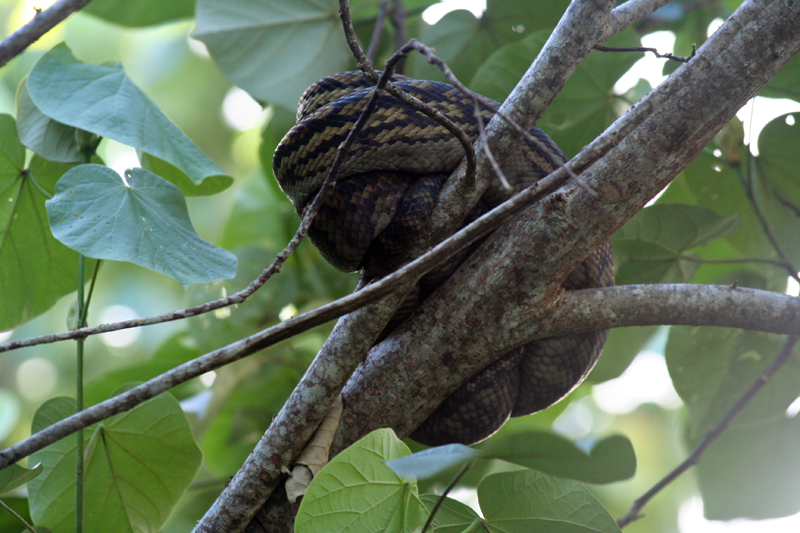 |
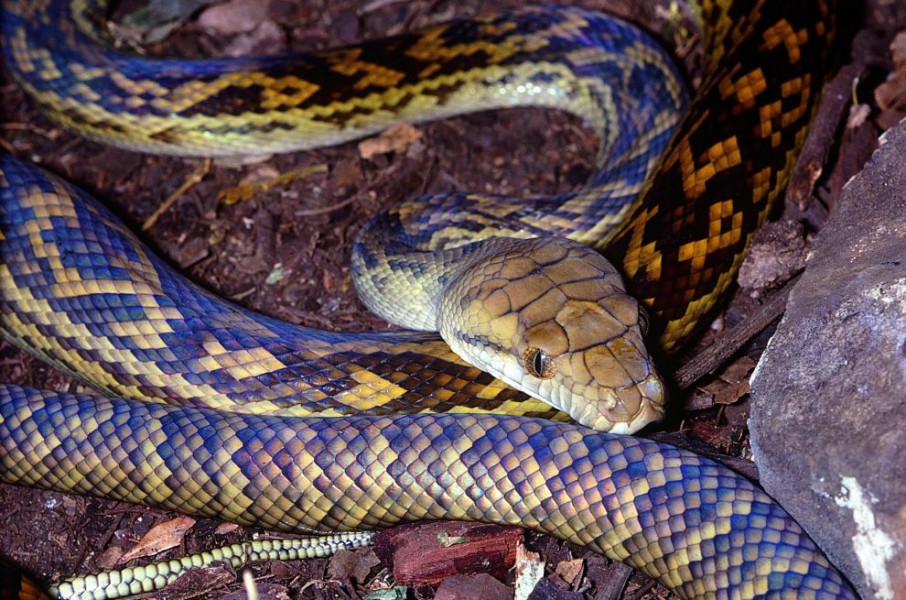 Amethystine python showing his true colors. Image stolen from The Reptile Zoo website. Amethystine python showing his true colors. Image stolen from The Reptile Zoo website.
Best of show for me was probably the big fat Amethystine Python coiled in a heap on a branch not far above our heads. There was just enough light left to catch a glimpse of his brilliant purple shimmer. Australia's biggest snake, Murray estimated it was probably ten to twelve feet long making it a fairly small example, but we were not complaining. I'd wanted to see snakes and I had been amply rewarded. |
As dusk began to lose the battle to night, welcome swallows and Australian swiflets swooped and soared after their suppers, and later still a few bats started to whizz by on the same mission. Murray conceded he could not be certain of the bat species, but otherwise he never missed a beat. He was pretty confident that at least some of them were spectacled bats.
I think it is fair to say that Murray and Clare were our favorite guides. We even invited them to dinner afterwards which I took to be an extremely good sign because I knew that all Claudia really wanted to do was to go home and crash.
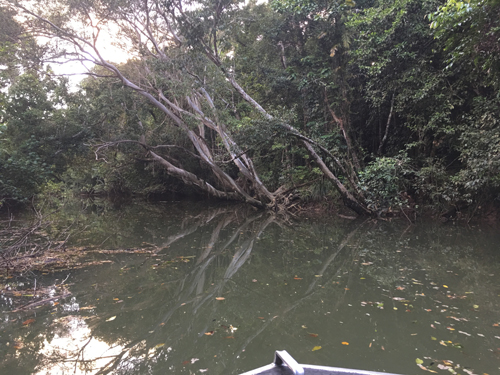
|
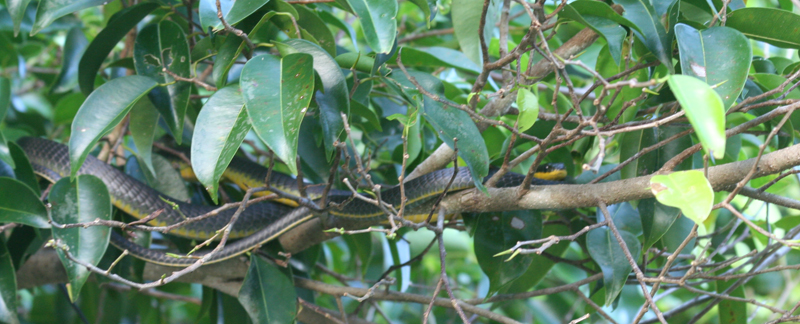 Above: The second and considerably more accessible green tree snake. "A slender, large-eyed, non-venomous, diurnal snake of many parts of Australia, especially in the northern and eastern coastal areas, and into Papua New Guinea". Above: The second and considerably more accessible green tree snake. "A slender, large-eyed, non-venomous, diurnal snake of many parts of Australia, especially in the northern and eastern coastal areas, and into Papua New Guinea".Left: One of the more jungley backwaters. Where we saw the fabulous frogmouths. |
